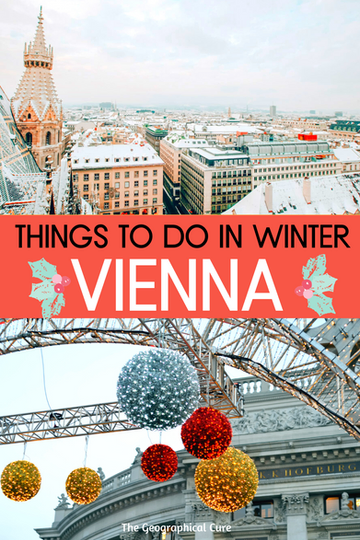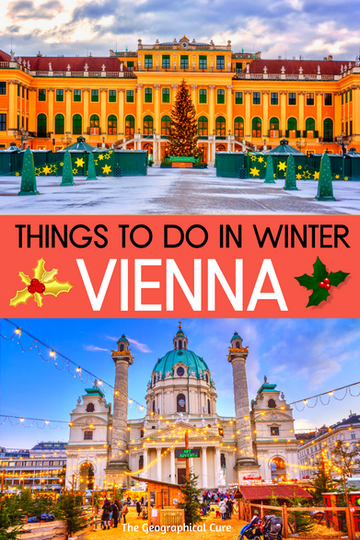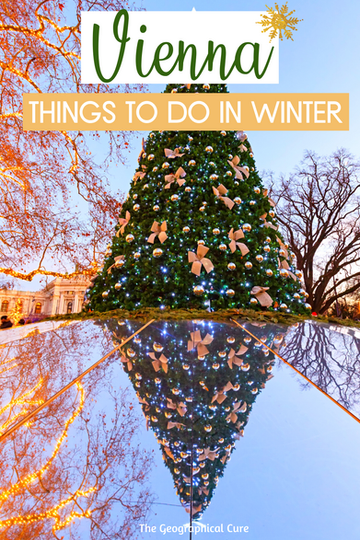Frohe Weihnachten! That means “Merry Christmas” in Austrian German. Austrians embrace the Christmas spirit and take the winter holiday season seriously.
In general, I love visiting Europe in the winter. Yes, it can be chilly, windy, and sometimes rainy.
But there are also vastly fewer tourists and lines. You can enjoy a cool and comfy tranquility, with some of the warmest memories imaginable.
In cities like Vienna, the twinkly lights and glittering imperial palaces glow like snow globes. Old world squares turn into magical Christmas markets.

Cozy coffee shops and restaurants offer up Viennese coffee, mulled wine, and gooey cream cakes — as if calories don’t count.
For 600 years, Vienna was the head of the grand Hapsburg empire. Vienna may have lost its political clout. But it’s still the home of Beethoven, Brahms, Strauss, Mozart, and artists like Gustave Klimit. Vienna knows how to live, and live well, no matter the season.
Here’s my guide to amazing things to see and do in Vienna during the winter season and Christmas.
Amazing Things To Do and See In Vienna in the Winter
1. Take a Wintery Stroll
Naturally, the best way to get to know Vienna is on foot. Bundle up and hit the streets.
Encircled by the grand Ringstrasse, the historic Old Town of Vienna, known as Innere Stadt, is a designated UNESCO World Heritage Site.
Today, the old town abounds in upscale shops and cafes lining pedestrianized Karntner Strasse and Graben. Art galleries and restaurants dot the surrounding streets.
If you’re visiting on Christmas Eve or Christmas Day, you might be the only one out exploring. You can snap photos and take in the beautiful white lights, pine boughs, and candles.
If you want a guided walking tour, try a Vienna History Walking Tour (learn about the Hapsburgs and Ottomans), a Ghosts & Legends Tour by night (Vienna’s haunted spots), or a Hitler Walking Tour (visit the war memorials and relive history).
Prefer a romantic ride by horse drawn carriage? There are 20 and 40 minute tours. You can find carriage stands in these city squares: Stephansplatz, Michaelerplatz, Albertinaplatz, Petersplatz and Burgtheater/Volksgarten.
>>> Click here to book a carriage ride
2. Visit Vienna’s Stunning Imperial Palaces
If you’re a history nerd like me, head inside and see how the Hapsburg monarchs lived. There’s nothing like a visit to Schönbrunn Palace, Hofburg Palace, and the Belvedere Palace.
You can admire world class art against the historical backdrop of the Habsburg dynasty. The Hapsburgs ruled the Austro-Hungarian empire for nearly 650 years. In winter, all three palaces will be decorated to the hilt for Christmas.
A bit outside of the city center, Schönbrunn Palace is Vienna’s #1 attraction. It’s been a UNESCO-listed site since 1996, and is the height of elegance. Purchase your tickets online in advance. Or hop on a skip the line guided tour.
The swishy Renaissance palace was the summer home of the Hapsburgs. You’ll want to check out the lavish stucco and gold rooms in the palace itself and the extensive garden complex (though it’s not as spectacular in winter, naturally). Plan to eat lunch at the Christmas Market.
Hofburg is one of the world’s biggest palace complexes. The Hapsburgs lived there until 1918. Honestly, I enjoyed it more than glitzy Schönbrunn. Far fewer tourists and just as much historical intrigue and swirly Rococo glitter.
Hofburg Palace is a lively combination of Rococo and Renaissance architecture. There are three parts you can visit: the Sisi Museum, the Imperial Apartments, and the Silver Collection. If you want to see everything, it will take the entire morning.
>>> Click here to book a skip the line Hofburg ticket
The Belvedere Palace is one of Vienna’s most visited tourist spots and another important UNESCO site, for its showy architectural ensemble.
The Belvedere Palace was built in 1712-23 by Johann Lucas von Hildebrandt, a master Baroque architect. The palace was the swishy summer residence of Prince Eugene of Savoy, a legendary military leader of his time.
3. Winter in Vienna’s World Class Museums
Vienna’s world class museums are some of the best things to do in the winter time. You escape the cold and admire great art.
The Belvedere Palace houses one of Europe’s most important museums. It’s definitely my favorite museum in Vienna. So if you’ll only make one “art stop,” this is the place to choose.
The Belvedere’s a haven of Baroque and Austrian art from the 19th and 20th centuries. Its main claim to fame is the world’s largest collection of Gustav Klimt paintings, including the world famous The Kiss. It also boasts masterworks by Egon Schiele and Oskar Kokoschka, two important Expressionist painters.
>>> Click here to book a skip the line Belvedere ticket
Alternatively, head to the Museumsquartier in Vienna. Opened in 2001, the Museum Quarter is dubbed Vienna’s “urban living room.”
The district is a cluster of old master and contemporary art collections in a “culture plaza” teeming with shops and cafes. It’s on the site of the old Hapsburg Stables. The Museumsquarter galleries are surrounded by the edgy Street Art Passage, for fans of graffiti.
There’s a lot to see here, if you’re a culture vulture. But you’ll have to choose, unless you want to camp out there for days.
I’m rather partial to the Leopold Museum, with its collection of Art Nouveau and Expressionist masterpieces from Egon Schiele and Gustave Klimt.
Another Vienna museum that I fancy is the Sigmund Freud Museum. Vienna was home to the godfather of psychoanalysis. Housed in his former residence, the museum explores Freud’s life and work. It’s a quirky and fascinating hidden gem in Vienna.
If you’re a Beethoven fan (and who isn’t?), Vienna is full of Beethoven sites. If you want to see and feel Beethoven’s ghost, head to the Beethoven Museum on the city outskirts. This tiny museum is superb and packed with Beethoven trivia.
4. Attend A Christmas Concert
To music lovers, Vienna is the musical capital of the world, home to Mozart’s Cosi Fan Tutti and Strauss’ the Blue Danube Waltz. More famous composers have lived in Vienna than any other city — Mozart, Beethoven, Joseph Hayden, Franz Schubert, Antonio Vivalidi, and Johann Strauss.
A cluster of these musicians are buried in Central Cemetery, and you can pay your respects.
During the Christmas season, concerts take place all over Vienna. You’ll find some of the most classic pieces being performed in beautiful concert venues.
Here are some good options for the musically inclined:
Mozart and Strauss at the Golden Hall
The Golden Hall concert features select works by Mozart and Strauss performed by the Mozart Orchestra of Vienna. The performers dress in period perfect Baroque costumes. You can literally relive Vienna’s musical past up close and personal.
Vivaldi’s Four Seasons in Karlskirche
Vivaldi is beloved for The Four Seasons, his most famous piece. The Karlskirche concert features a selection from each season, with a little Mozart and Bach music spritzed in for good measure.
As a bonus, you can visit the Christmas market for a post concert snack or drink.
Vienna Hofburg Orchestra in the Hofburg Palace
The Vienna Hofburg Orchestra performs in the magnificent halls of the Hofburg Palace. Their concerts combine orchestra musicians and vocal soloists.
Each year, on December 25 and 26, the orchestra hosts Christmas concerts featuring popular music by Strauss and opera arias and duets by Mozart. The Hofburg Orchestra also performs at the Vienna Staatsoper, the Vienna Opera House.
Classical Ensemble at St. Peter’s Church
Winter in Vienna is a perfect time to visit the stunning 400 year old Baroque church, St. Peter’s Church, and attend a concert. The church hosts an intimate and inexpensive ensemble concert playing traditional pieces.
Experience an Opera at the Staatsoper
One of the world’s most stunning opera houses, the Vienna Opera House, is a must see site in Vienna. Dating from 1869, it’s a magnificent and storied building. The opera house has played host to some of the world’s best singers and conductors, such as Maria Callas and Luciano Pavarotti.
You can take a 40 minute guided tour of the sumptuous palace several times a day. Be sure to check the website for times. Or book tickets to see an opera here.
If you want to splurge, buy tickets for the Vienna Opera Ball in February.
You can dance away the night in the elegant ballroom, stroll through the opera house admiring the sumptuous decor and 19th century frescos, and enjoy the various music offerings.
The Vienna Philharmonic
The Vienna Philharmonic is one of the world’s best orchestras, performing in the Palais Auersperg. The Philharmonic has been performing live since 1842. Its New Year’s Eve concert at the Hofburg Palace is an annual tradition.
5. Hit the Christmas Markets
Nothing screams winter in Vienna quite like Christmas markets. Christmas Markets are an ancient medieval tradition in Vienna. The first ever Christmas Market was held in 1294.
Today, Vienna has a plethora of Christmas Markets, each with its own personality and more beautiful than you can imagine. They’re like cozy villages within a big city.
Be sure to bring cash to the markets. Most stands don’t accept cards. The markets are generally open from mid November to Christmas or New Years.
You can shop for fine Christmas crafts, enjoy the wafting smell of delicious foods, and indulge in the many culinary delights — gingerbread, wiener schnitzel, sausage, roasted chestnuts, roasted dumpling, filled doughnuts, or apple strudel.
>>> Click here for a tour of the Christmas markets
There are over 20 formal Christmas markets during winter in Vienna. Here’s a sampling of the best ones:
Christkindlmarkt on the Rathausplatz
This is the biggest, liveliest, and most decorated Christmas Market in Vienna, with a real wow factor. Expect plenty of crowds here.
But it’s worth it for the breathtaking backdrop of the City Hall. At night, the lights glimmer, a sparkling advent arch welcomes you, and you’ll see Vienna’s largest Christmas tree.
Weihnachtsmarkt am Spittelberg
Unlike most markets, Spittelberg is an intimate market tucked away in a bohemian neighborhood. It’s set up on several streets with quaint cobbled lanes and Beidermeier townhouses.
You’ll find local merchants selling beautiful handmade items, including Gustav Klimt inspired crafts.
Karlsplatz Art Advent
This upscale market is smack in front of Austria’s most beautiful Baroque church, Karlskirche. The food is organic and the crafts on display are selected by a panel of rigorous judges. There’s also hay bales, a petting zoo, and an amazing Raclette stand.
Altwiener Christkindlmarkt on the Freyung
Dating back to 1772, Freyung is the oldest Christmas Market in Vienna, set in a triangular cobblestone square in the heart of the city. It also has the distinction of being one of the most authentic markets.
You can shop, eat, and drink amidst seasonal music. The back row of stalls sport a nativity scene painted by Josef Ritter von Fuhrich.
Weihnachts Mark Am Hof
The Am Hof Christmas Market is located in a central square with historic buildings and a column dedicated to the Virgin Mary. It has scrumptious food, a champagne bar, and high quality jury-selected handmade goods.
Weihnachtsdorf in Maria Theresian Platz
Between the Kunsthistorisches Museum and the Naturhistorisches Museum, this is another relatively uncrowded market. It’s open longer than most. It turns turns into a New Year’s Market just after Christmas. Here’s where you can sip a traditional Vienna Christmas Market drink, Mozart Punsch.
Weihnachtsmarkt Stephansplatz
Located at the base of the Vienna’s Gothic St. Stephens Cathedral in the heart of Vienna is the Stephansplatz Christmas Market. The market is tiny, but lovely and centrally located near other markets. Glittering stalls wrap around the cathedral like a Christmas wreath.
Winter Market on Riesenradplatz
This market is located in the Prater Amusement Park. You can enjoy live music as you take a twirl on the the Riesenrad Ferris Wheel Plus. The market is open into January, so you can still get your Christmas Market fix well after New Year’s.
Belvedere Palace Christmas Village
If you love palaces and art, it’s worth the trek by tram/walk/taxi to the Belvedere Palace Christmas Village, right on the palace grounds.
Beautiful at night with the palace as a backdrop, the market is relatively small and authentic. You’ll find traditional handcrafted items and can sample a gooey Raclette.
6. Ice Skating at the Eistram
In winter in Vienna, there are ice rinks set up all over the city. Some are installed against magnificent backdrops.
The most famous one is Vienna Ice World in front of City Hall. From January to March, the Eistraum transforms the area into an ice skating rink. It’s a massive 8500 ice space, where you can skate to the music of Strauss on multi-levels.
7. Cold? Indulge in Vienna’s Coffee Cafe Culture
Vienna is serious about its coffee culture. Vienna has a long history of inventing unique coffee drinks and pioneering coffee shop culture. The first coffee house in Europe opened in Vienna in 1684.
Vienna’s coffee shops are a far cry from Starbucks. They’re opulently decorated formal spaces.
You can sink onto a damask couch and linger over coffee and a pastry, which will be served on a silver tray by a starchy uniformed waiter. It’s a uniquely Viennese experience.
There’s also a wide variety of coffee drinks that are unique to Vienna. The most popular is Vienna Coffee. It’s a cream based coffee created by infusing two shots of espresso with whipped cream, topped with whipped cream and chocolate.
Cafe Central is one of Vienna’s most famous coffee shops, once frequented by Freud and Trotsky. It’s traditional in style, with stunning architecture and deletable Viennese cuisine, homemade cakes, and pastries.
This place has historical roots as a legendary literati cafe, which counted Arthur Schnitzler, Peter Altenberg, and Adolf Loos among its frequent patrons. Everything about the place oozes sophistication and class.
Demel is is the ultimate Viennese chocolate shop, where choco-dreams come true. The pastry shop and cafe even boasts the title of Purveyor to the Imperial and Royal Court.
The shop is on the first floor and cafe on the second floor. It’s the perfect place to buy Art Nouveau boxes of chocolate souvenirs to bring home.
Across from the Vienna Opera House, you can splurge on Vienna’s most iconic dessert, the Sacher Torte, at the historic Cafe Sacher. The torte consists of two layers of dense chocolate sponge cake filled with a slice of apricot, which is then covered with chocolate ganache and a dollop of whip cream.
Cafe Sacher earns its reputation. It exudes old school luxury, with smoked mirrors, chandeliers, and perfectly dressed Viennese butlers set against red interiors.
>>> Click here to book a coffee tour experience
8. Huddle in St. Stephens’ Cathedral and Climb A Tower
Right in the heart of historic Vienna, you’ll find the showy Romanesque-Gothic St. Stephens Cathedral. It’s Vienna’s defining landmark. You can’t miss it. Its most distinctive feature is its gaudy multicolor tiled roof, which looks glorious in the sunshine.
Both towers of the cathedral are open to the public and can be climbed for a fee. The south tower is high and affords the best views of the city (and the exquisite roof). That’s the one I chose.
The interior of St. Stephens is not as eye catching as the exterior to my mind, rather gloomy. But its three nave design is nonetheless impressive to behold.
>>> Click here to book a cathedral ticket
9. Celebrate New Years Eve in Vienna
The Viennese enjoy their New Years Eve celebrations.
There are fireworks in front of City Hall and at the Prater at midnight. There’s a ball at the Hofburg Palace. And the bell of St. Stephen’s clangs at the stroke of midnight.
The Silversterpfad is Vienna’s “New Year’s Eve Trail” that runs from the afternoon of December 31 to the wee hours of January 1. You’ll find temporary stages with live performances, waltz classes, music, and more.
Tips for Visiting Vienna in Winter
There are some things you should know about making a winter visit to Vienna.
1. Austrians celebrate the Christmas holiday on Christmas Eve. So if you arrive on Christmas Eve, expect Vienna to be mostly shut down, with empty streets and closed Christmas markets.
2. Many Viennese restaurants are closed from Christmas to New Years. Check before you go. Or plan on eating at the Christmas markets.
3. Shops in Vienna are closed every Sunday year round. Some larger stores are open in the mornings. But they all close between Christmas and New Years.
4. Many attractions have shorter opening hours in the winter, often closing at sunset. So be sure to check the winter hours online.
5. Vienna will be cold in the winter, around 0 celsius. Bring waterproof shoes, warm clothes, and plan on wearing layers.
6. Vienna is fairly walkable. But if you plan to use the trams or trains, buy a Vienna City Card for your trip. The card works on all types of transportation and is a money saver, also giving you discounts on what can be hefty museum entry fees.
7. Don’t buy tickets to musicals or other attractions on the street. It’s better to purchase them from the venue directly to avoid scams or overpriced bad seats.
I hope you’ve enjoyed my guide to the best things to do and see in winter in Vienna. Here are some of my other Austria guides you might enjoy:
- 3 Day itinerary for Vienna
- Guide to the Belvedere Palace
- Gustav Klimt Guide to Vienna
- Must See Sites Along the Danube River
- Guide to Wachau Valley
- Guide to UNESCO-Listed Melk Abbey
- Guide to Vienna’s Empress Sisi Museum
- Beethoven Guide to Vienna
f you’d like to visit Vienna in the winter, pin it for later.


